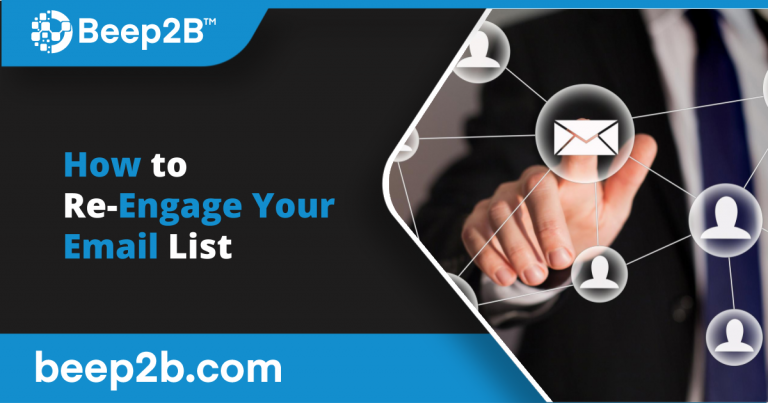Building an email list is important for connecting with your target audience. Yet, building your list is not the most difficult or most important part.
Far too often, people go through the effort of building a list and do not use it to its full potential.
One of the most common questions we hear about email marketing is “I already have an email list, but I haven’t emailed them for a very long time. What should I do?”
Today, we’ll dive into the most effective ways to re-engage your email list. Read on to find out why, and how, to do so.
Should I Re-Engage my Email List?
Whether you build your list a few months ago or a few years ago, starting fresh can be very tempting. Once your list has sat stagnant for a while, you may feel like it’s not going to be useful.
If your direction has changed and the list no longer seems applicable, then starting a new list may be wise.
But before you jump right into a fresh start, consider the immense benefits of re-engaging an existing list.
New leads are expensive and difficult to acquire. You already have a list of them. Re-engaging existing leads is much less expensive and more efficient. These people previously engaged with you, you don’t have to start with a blank slate as you do with people who may have never heard of you.
A higher conversion rate is another key benefit. Since your current list engaged with you before, you have some base to work from. There’s a greater chance that you can find a previous customer or a warm lead who will convert to a different product or service.
Email List Re-Engagement Campaign
Chances are, re-engaging your existing email list will be beneficial for your business. If that’s the case, then you should create a compelling re-engagement campaign.
Here are the components of your re-engagement campaign.
Planning
Planning should always come first. Take your time on this step, because planning makes all of the difference later in your campaign.
Begin by planning out your campaign in your calendar. Consider the following:
- How many total emails will the campaign include?
- How many days will you leave between emails?
- When will the emails go out?
- What other content do you have planned for this time period?
- Can your other content fit into your email campaign?
3-Email Campaign
When it comes to re-engaging your list, there is a sweet spot for the number of emails. Just one email isn’t enough. You’ve left them hanging for some time, and one email won’t get their trust or interest. You’ve got to prove that you’re serious and have something to offer, yet you do not want to be annoying.
Three is a great balance for the re-engagement campaign. It’s enough to warm your audience back up and feel them out. Yet, it’s not so many that it’s overbearing. Start out with a 3-email re-engagement campaign.
Following the campaign, bring your leads to your regular email list. On your regular list, consistently share new content on a scheduled basis (once a week, every other week, once a month, etc).
Email #1: All About Your Audience
Think about your email list like a crush whose number you got, but then you never called about setting up a date. If you jump right in and ask for the “date”, there’s not a very high chance they’ll accept. You’ve got to make up some footing first.
Make the first email all about your audience. Briefly accept responsibility for “neglecting” them for a bit, but don’t make the entire email a long-winded apology.
After your acceptance of guilt, remind them why they signed up for your email list in the first place. Explain what value you will provide them with your emails. Focus the bulk of this first email on how your emails will help them.
Who are you? What is your business about? What do you offer that will help them achieve their goals and dreams? It’s been so long they may have forgotten. So remind them.
The cherry on top of this email is offering a free gift. Offering a free downloadable checklist, whitepaper, eBook, etc will go a long way. It shows that you will offer value and that you’re here to stay.
Email #2: Share a Relatable Story
After you’ve gotten the (re) introductions out of the way in the first email, it’s time for a story. Use the second email to share a story your audience will relate to. The key here is to make sure it’s a story they can learn from.
Make the lesson crystal clever. Explain how the lesson from the story can improve their lives or businesses.
Again, add a little freebie to get them excited about the value you can offer. These freebies don’t have to be huge, just helpful. Maybe it’s part two of the freebie you shared before or some other small downloadable.
Email #3: Aks How You Can Help
Now, in the third and final email of the campaign, you want to elicit a response. This still isn’t the time to try to convert sales. Rather, try to get a response.
Ask your list how you can help them, what they need from you. Ask them to reply directly to the email so you can provide them with something valuable that may help them.
In this email, clearly outline what they can expect from your future emails. How will your emails provide value to them? And when can they expect them?
After this email, move them to your regular email list. From here on out, focus on delivering value with every email and keeping the list engaged.
Email List Re-Engagement Tips
Here are some additional tips for your re-engagement campaign:
- Encourage people to unsubscribe. It sounds counterintuitive. Why would you want people unsubscribing, especially when you’re trying to re-engage them! You want a clean list, filled with people who are interested in what you’re sharing. Having people on your list who delete every email without opening won’t help you or them. Always remind them that they can unsubscribe at any time, and make sure this is clear and easy to do.
- Move forward. Once you make the decision to re-engage the list, there’s no going back. You cannot let the list die off again, because it can really only be re-engaged once. Make sure you are ready to re-engage, with a plan moving forward.
- Repurpose content. You don’t have to create something brand new for your emails. Use the content you create elsewhere. You can repurpose the content into an email newsletter, or you can use the email to promote the content you are sharing elsewhere. This ensures that you can always share something of value, and it also helps you get your content in front of your audience.
Get Started!
Before you go out to create a whole new email list, take a look at the ones you may have let fall by the wayside. Re-engaging your existing lists gives you a leg up and can help you sniff out warm leads much easier. Using the strategies above, you can effectively re-engage your email list and set yourself up for email marketing success.


